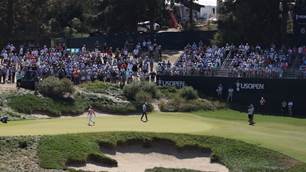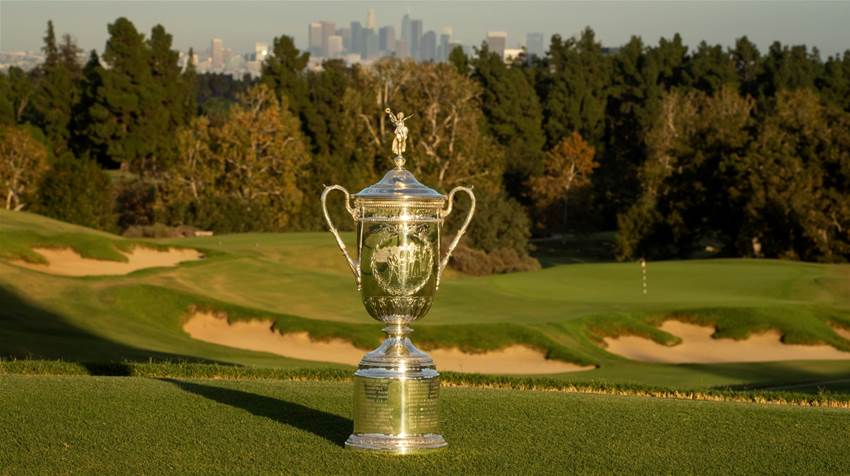It’s hard to fathom why the second-most populous city in North America, behind New York City, and one of the most famous cities in the world, has seemingly been ignored by the United States Golf Association for so long.
The last time a U.S Open Championship was contested in the City of Angels it was won by Ben Hogan at the Riviera Country Club. The year was 1948.
That’s right, the U.S Open trophy, one of the most prized pieces of silverware in the game, has not been seen in Los Angeles for 75 years.
Which is all the more surprising when you consider the money and influence to be found everywhere in a city like L.A.
But the trophy’s L.A exile ends this week with the 123rd U.S Open Championship to be played at the historic Los Angeles Country Club (LACC) and its North Course. It’s ironic that in a city where a vast proportion of its population like screaming for attention, the U.S Open will make its L.A return to an exclusive private club that prefers the comfort of a low profile.
Located on Wilshire Boulevard, LACC is a golfing oasis on arguably some of the most expensive real estate in the world. Of course, there is the lengthy list of American pop culture icons to be found beyond its boundaries in Beverly Hills and Bel-Air, including famous luxury hotels like the Beverly Hilton, Waldorf Astoria and Plaza, which are a stone’s throw from the property. A bit further on, there’s the palm-tree lined Rodeo Drive and Santa Monica Boulevard, immortalised in song by Sheryl Crow, while the mansion at 10236 Charing Cross Rd, otherwise known as the Playboy Mansion, overlooks the North Course’s 13th green.
Facelifts, rebuilds and augmentations are commonplace in this neck of the woods, with some being more successful than others. Perhaps the greatest-ever Beverly Hills ‘facelift’ was unveiled in 2011 when the LACC re-opened the remaining holes of its North Course restoration.
The roots of the LACC stretch back to 1897 and a nine-hole course in downtown Los Angeles. The club moved to its current home – a Beverly Hills bean and barley farm – in 1911. In the decade that followed, the club purchased additional land and Englishman Herbert Fowler was commissioned to design two courses, the North and South, which opened for play in 1921.

Fowler was late to the game of golf. After retiring from playing county cricket, he took golf more seriously and within a few years he was a member of the R&A and playing off a scratch handicap. In 1900, at the age of 44, he finished 26th in The Open Championship at St. Andrews.
His path into golf course design was forced upon him to pay off a debt to his brother-in-law. To clear the balance, he surveyed and laid out 36 holes across a 600-acre heather-covered site for a new club in 1904. That club was the highly acclaimed Walton Heath and Fowler’s reputation was established with his first foray into course architecture.
That reputation for strategic design put him in great demand throughout Britain and later drew him to the United States, where he created the two LACC courses.
Fowler’s primary construction engineer was George C. Thomas Jnr, who was a relatively new LACC member having moved to California from Philadelphia where he regularly exchanged views and ideas with the likes of Donald Ross, A.W Tillinghast, Hugh Wilson and George Crump – all considered among America’s finest course designers of the time.
After the club hosted the first L.A Open on its North Course in 1927, modifications were made by Thomas, who had just created the nearby Riviera and Bel-Air Country Clubs. Most of the North Course was revamped and several new holes created under Thomas’ redesign.
But over the next 75-odd years a combination of poor board decisions and flora allowed to grow out of control had negatively impacted the character of the course. Perhaps it was with one eye on one day hosting a major championship that LACC decided to undertake a multi-million-dollar restoration, commissioning course architect Gil Hanse, his design partner Jim Wagner and golf historian Geoff Shackelford to complete the project.

Hanse, who has also restored recent U.S Open hosts sites at The Country Club Brookline, Winged Foot, Merion and Oakmont, counts the LACC North Course restoration as the most significant of his career.
“I can say without hesitation we learned more on this project – about ourselves, about relationships with clubs, and certainly about George Thomas and golf architecture – than on any other project we’ve ever been associated with,” Hanse said of the project that began in 2006 and was completed five years later.
The work included rediscovering and restoring the original bunkering style, which was inspired by the creations of other Golden Age course architects and constructed by Thomas’ partner William ‘Billy’ Bell, a former course superintendent who also worked with him at Riviera and Bel-Air.
Hanse’s team also used old course photography to return Thomas’ green complexes back to their original locations, while nearly 80 years of poorly managed tree growth and ground cover had to be removed if the Hanse restoration was to be deemed successful.
The USGA tested the waters of the North Course by playing the 2017 Walker Cup matches there, which was the first major event played at LACC since the 1954 U.S Junior Amateur. Adding to the resounding 19-7 victory for the American side was the overwhelming favourable feedback for Hanse’s renovation.
The North Course’s hilly terrain presented Thomas and Bell several options for the routing of holes, placement of tees, hazards, and greens. The genius of the design is how the roll of the landscape, the barranca weaving the course and the little bumps and hollows have been used to create holes that look as if they existed here long before the likes of Fowler, Thomas, Bell or Hanse came along.
There is, also, short grass everywhere. Hopefully the USGA won’t be tempted to alter this welcoming aspect of the Hanse design too much as it is enough to almost transport you to the heart of the Melbourne Sandbelt. This short grass is not only a far greater defence of par, but it connects one hole with the next so beautifully.
Another aspect of the North Course that strikes a chord for Sandbelt aficionados is the creative greenside and fairway bunkering, which add to the strategic questions you must ask yourself on each tee and on every approach shot – questions that change from one round to another with the positional change of the tees and the flags.

The greenside bunkers are deep, intimidating but totally playable. The edges have that wild, rugged look and, just like the Sandbelt, the faces are steep and firm, so shots don’t plug in the face and balls roll to the bottom.
On many of the par-4s, there is an embedded bunker in the middle front of the approach, creating a ‘pinable’ section left and right of the bunker, adding more strategic questions and decisions to be made on the run.
For Hanse, the network of gullies and dry creek beds cutting through the North Course add another level of strategy that could easily see significant scoring swings during the U.S Open.
“The characteristic that is most prominent in my mind is the barranca that runs predominantly through the front nine and provides a significant amount of strategy,” Hanse told usopen.com.
“Thomas incorporated it in many ways – it fronts some of the greens and parallels some of the holes, while on other holes you have diagonal carries over it, so he utilised it dramatically. Although I don’t think it’s unique to Southern California, it’s an identifying trademark of the great Thomas courses here.”
The potential for drama and dropped or gained shots can be found from the 2nd hole, a 497-yard par-4 where the long approach shot is to a green set above the barranca. Golf Australia course architecture editor, Mike Clayton, often refers to some holes as being a four and a half par. It won’t surprise if this hole plays a full shot over par during the U.S Open.
The par-70 North Course is unusual in that it features five par-3s and three par 5s – one more of each than is typical for a U.S. Open. And it might just be the one-shotters that will separate the contenders from the pretenders during the championship.

The downhill, 290-yard 11th hole, with a reverse Redan green complex – played against a downtown L.A backdrop – is an intimidating prospect as you stand on the tee. As is one of the shortest par-3s in U.S Open history that comes into play just four holes later.
The 15th is an incredible hole that can be played as short as 75 yards or as long as 130 yards across flat terrain to a tilted, almost boomerang-shaped, green where the tops of the surrounding deep bunkers obscure the view of the putting surface with its small mound dividing clearly defined back and front sections.
It will be interesting to see how the game’s best players work their way around this course as it is very different – with the exception of Thomas’ Riviera CC up the road – to what they play on Tour for the rest of the year.
While many, like World No.2 Jon Rahm, visited the course for practice rounds earlier in the year, only a few players have been tested here in competition, which may prove advantageous. Major champions Scottie Scheffler and Collin Morikawa were part of the victorious American Walker Cup team here in 2017, and both have the high quality of precise ball-striking needed to perform well at LACC.
The 123rd U.S Open will not be won by a player who bombs and gouges their way to the trophy presentation. LACC is not the type of course. According to Hanse, victory will go to the player who best appreciates the course, respects it and thinks their way around it.
“I think this is one of the masterpieces of golf course architecture, not only in the United States but in the entire world,” Hanse told usopen.com.
“Seeing the best players on stages like this is an amazing opportunity for people who love golf architecture and love the possibilities, as opposed to the game just being a power game.
“I believe this course is going to produce a winner who is very cerebral in the way they approach it and I think that will be very fitting for this championship.”
Related Articles

U.S Open heading to Riviera in 2031

Morri: Focus on interesting, not hard or easy



.jpg&h=115&w=225&c=1&s=1)









